Affiliate disclosure: This post may contain affiliate links. Please see our Privacy Policy.
Dandelion salve is perfect for treating minor skin irritations and sore muscles. Easily one of the most recognized wild plants, the cheerful dandelion contains potent anti-inflammatory and skin-healing compounds, making it the perfect herb for soothing salves.
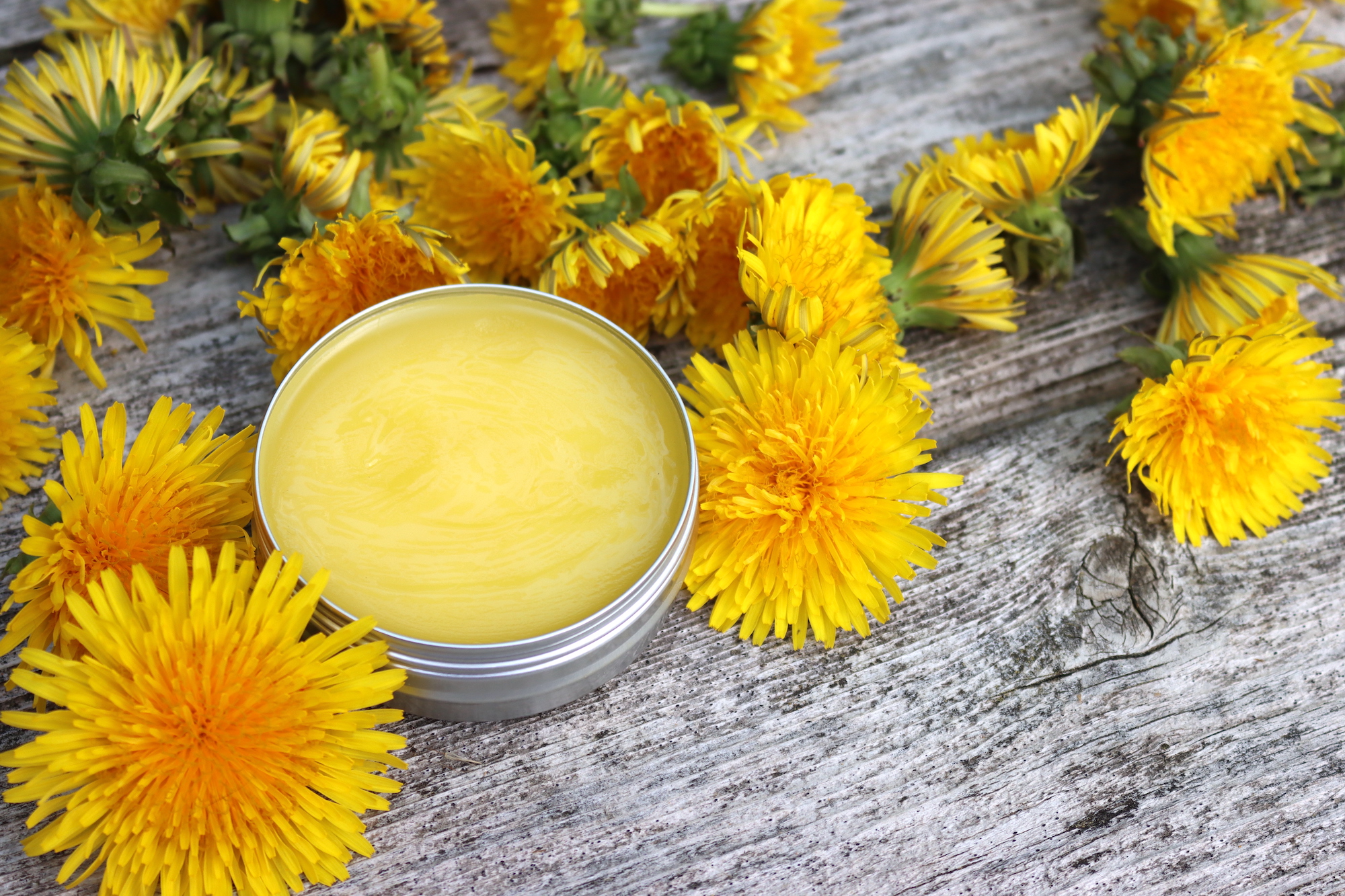
Dandelions (Taraxacum spp.) are familiar herbs even among novice foragers and herbalists. They spring up everywhere, in lawns, playgrounds, parks, pastures, and even cracks in the sidewalk. Their bright flowers and fairy-like plumes of wind-borne seeds easily catch the attention of pollinators and young children.
Generally, foragers start experimenting with dandelions in a culinary sense, using the early greens for salads and stir-fries or fermenting the blooms with sugar to make sweet, floral homemade wines. While I appreciate these creative culinary uses, for me, dandelions serve best as medicinal herbs.
One of my favorite ways to use dandelion is to create an anti-inflammatory salve that treats sore muscles, chapped, dry skin, irritation, redness, and swelling from conditions like eczema, psoriasis, and acne.
Dandelion salve is pretty simple to make, but if you’re not up for an extra project, you can always buy some. You won’t find dandelion salve at most stores, so I suggest checking with small herbalists selling it through Etsy.
Have you ever grown dandelions? Cultivating dandelions in a garden bed can improve your harvest and make harvesting the roots much simpler. One of my favorite small Vermont seed companies, Earthbeat Seeds, carries seeds for the common dandelion (Taraxacum officinale). You can also find some interesting dandelion species, like pink dandelions (Taraxacum pseudoroseum) from Baker Creek Heirloom Seeds.
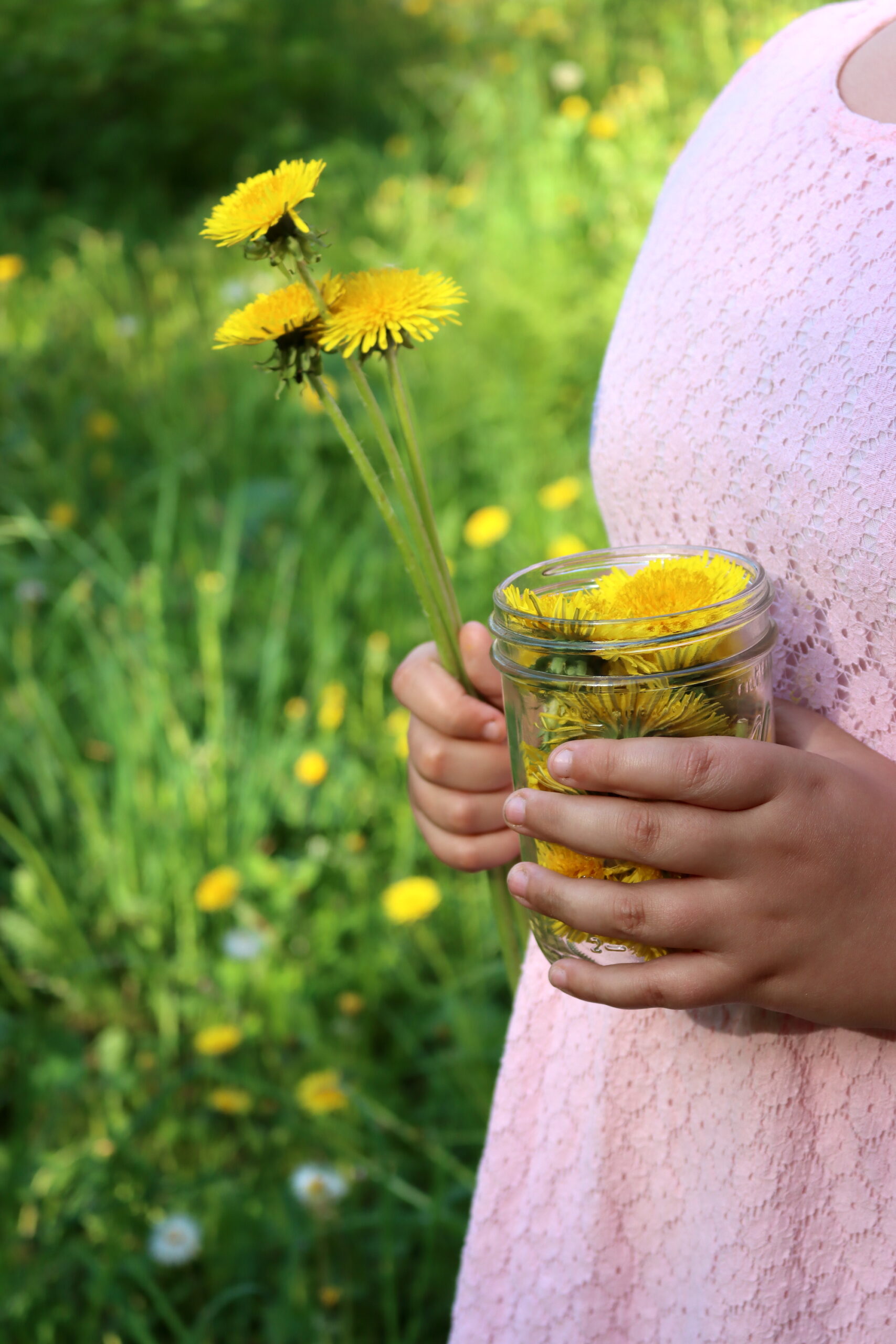
(Don’t use any wild plant unless you are 100% certain of its identification. Even common herbs like dandelions have lookalikes. Always check with your doctor or a clinical herbalist before using any herbal remedy that’s new to you. Wild herbs can cause unexpected reactions and side effects even when properly identified and used. For dandelion in particular, those allergic to plants in the Asteraceae or daisy family may be sensitive to it. This information is based on my own research and experience. I don’t have any qualifications to treat or diagnose your health conditions. Always do your own research and verify herbal information with multiple reputable resources.)
Benefits of Dandelion Salve
Native American, European, and Asian herbalists have all used dandelions for hundreds of years, and in modern times, we’ve seen them used as an ingredient in cosmetics. Many people believe that dandelions are great herbs for skin care, protecting the skin, and treating conditions like eczema.
Although research is limited, there have been a few animal and test-tube studies that suggest that herbalists and cosmetic companies are on to something. One study found that a dandelion extract increased the generation of new skin cells. Another study indicated that it can help reduce skin inflammation.
Personally, dandelion salve is now my go-to for dealing with the dry, cracked hands that come with life on a homestead during a cold Vermont winter. There’s no way to protect my hands from everything, but the dandelion salve has made a significant difference.
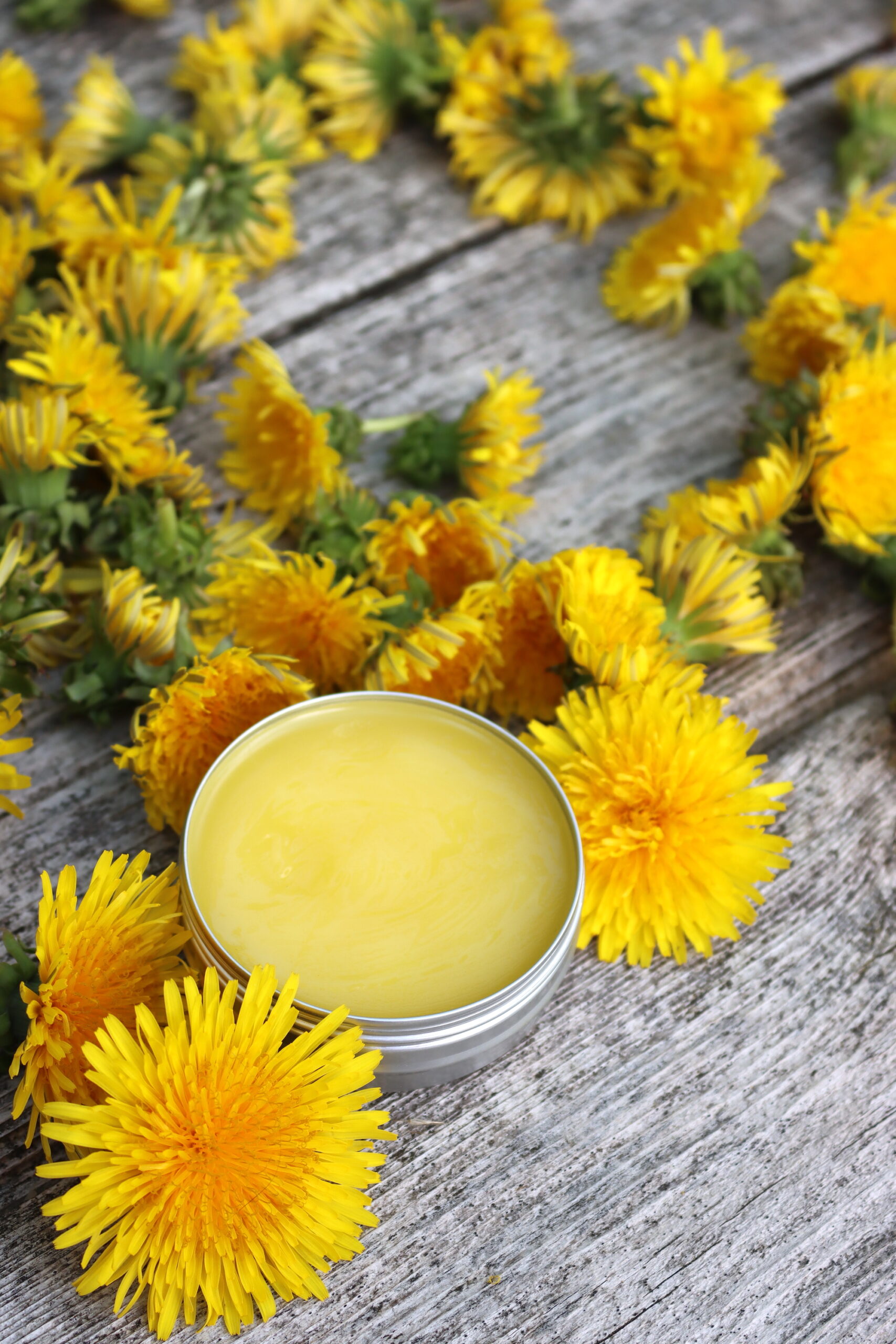
Supplies & Equipment
Making dandelion salve is simple! All you need is a few basic pieces of kitchen equipment and a few ingredients.
First, you’ll need a double boiler. You can buy one like one of these or you can DIY your own. I use a DIY double boiler set up made from a small pot and heat-proof container. You can also swap the pot for a slow cooker.
You also need a neutral oil to infuse with dandelion to create your salve. I use olive oil because I keep it on hand for cooking, but you can also use coconut, almond, grapeseed, or jojoba oil. These oils are excellent because they don’t have strong smells and are soothing for the skin. Feel free to experiment with what works best for your body.
Once we’ve infused our oil, we’ll need to thicken it. To do this, I use beeswax pellets. They thicken the salve and help it set up. I like the pellets because they’re easy to work with and measure, but you can also cut beeswax from a large block if that works better for you.
Another tool that I have found indispensable is a small kitchen scale. There are many affordable options, and they’re great for precisely weighing beeswax and other ingredients. If you don’t have a scale, you could grab pre-measured beeswax in 1 oz bars like these.
Lastly, you’ll need something to store your finished salve in. A little goes a long way when using your salve, so I like to use small containers. I usually use 2 oz metal tins. They’re sturdy enough to toss into a backpack for trips but pretty enough to give as gifts. You can also use quarter-pint mason jars or other small, upcycled glass containers.
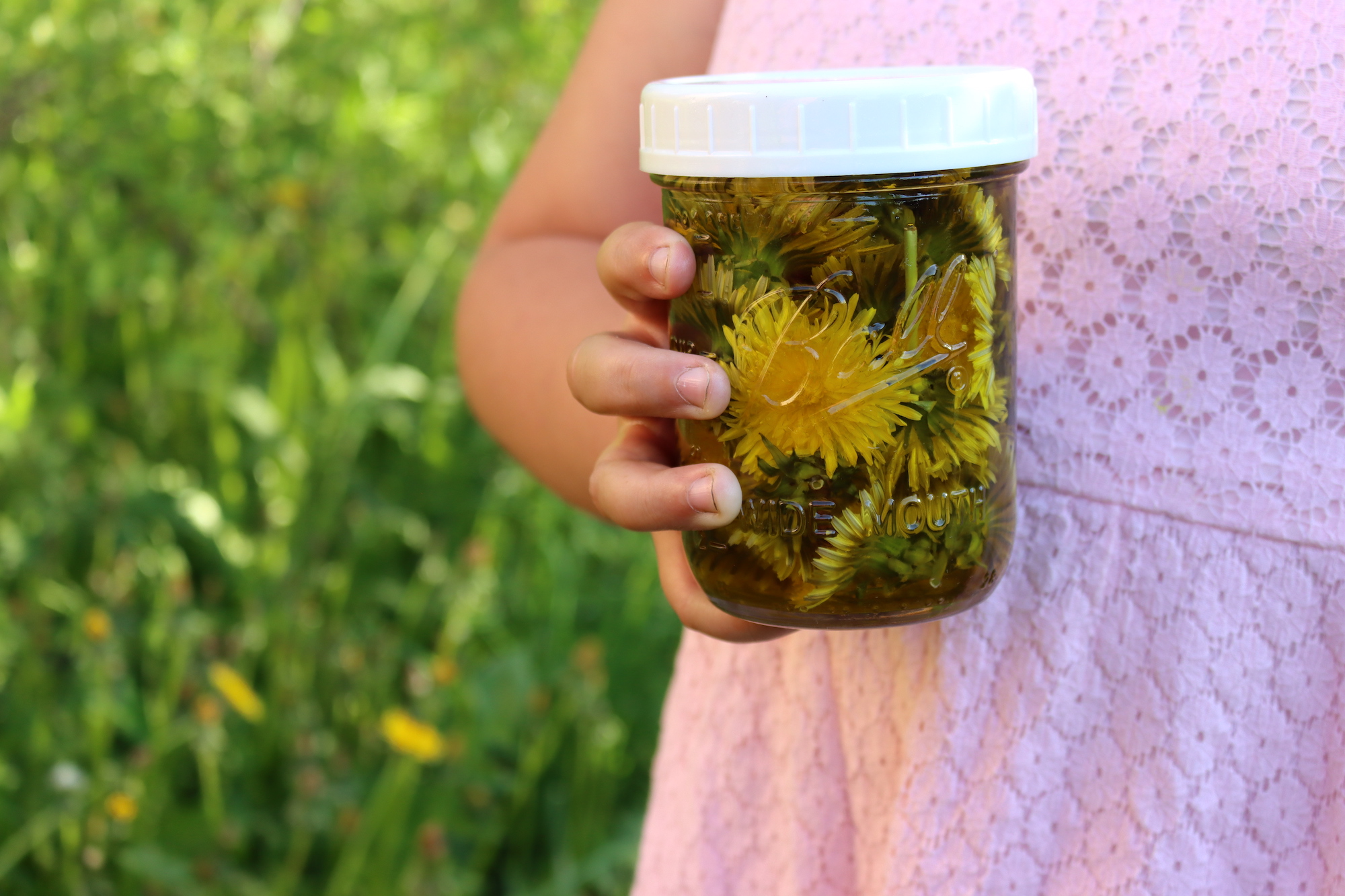
How to Make Dandelion Salve
Making dandelions salve is probably easier than you think. You only need to do about 30 minutes of active prep time, and the rest is pretty much a waiting game. For this recipe, I’ll teach you the warm, rapid infusion method. This technique cuts that waiting time down to 24 to 48 from about three to six weeks.
If you want to learn more about salve making, I highly recommend checking my guide to herbal healing salves for more detailed explanations and instructions.
The technique we’ll be using today, the warm rapid infusion method, is the best choice if you’re working with fresh plants. You could opt for a cold long infusion instead, but you risk the fresh plant material going rancid and spoiling over the longer process. If you opt for a cold infusion, I recommend drying your plant material first.
Dandelions are edible and medicinal in their entirety, including their roots, leaves, flowers, and seeds. However, for this salve recipe, we’ll be using the flowers. Select flowers that look fresh and like they have just opened; avoid picking older flowers. Use scissors or your finger to pinch or cut the blooms right below the flower where the stem starts.
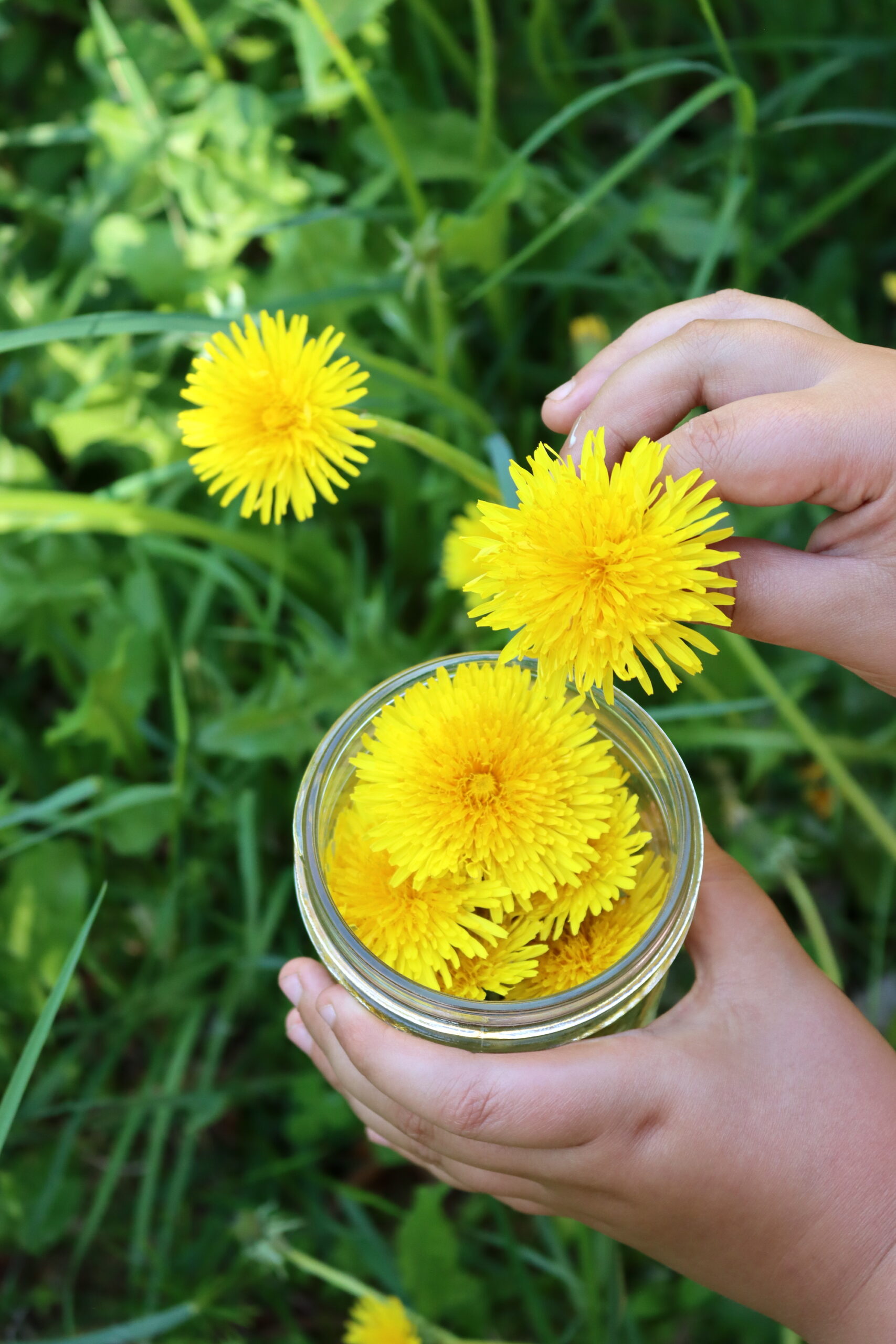
You need to collect enough dandelion flowers to fill a pint mason jar when they have been firmly packed in. You can use the flowers whole or use scissors or a knife and cutting board to chop them up a bit. Cutting the dandelion flowers into pieces increases their surface area and allows the oil to infuse more quickly.
Once you have a jar packed almost full of dandelion flowers, it’s time to cover them with the neutral oil of your choice. Leave just a bit of headspace.
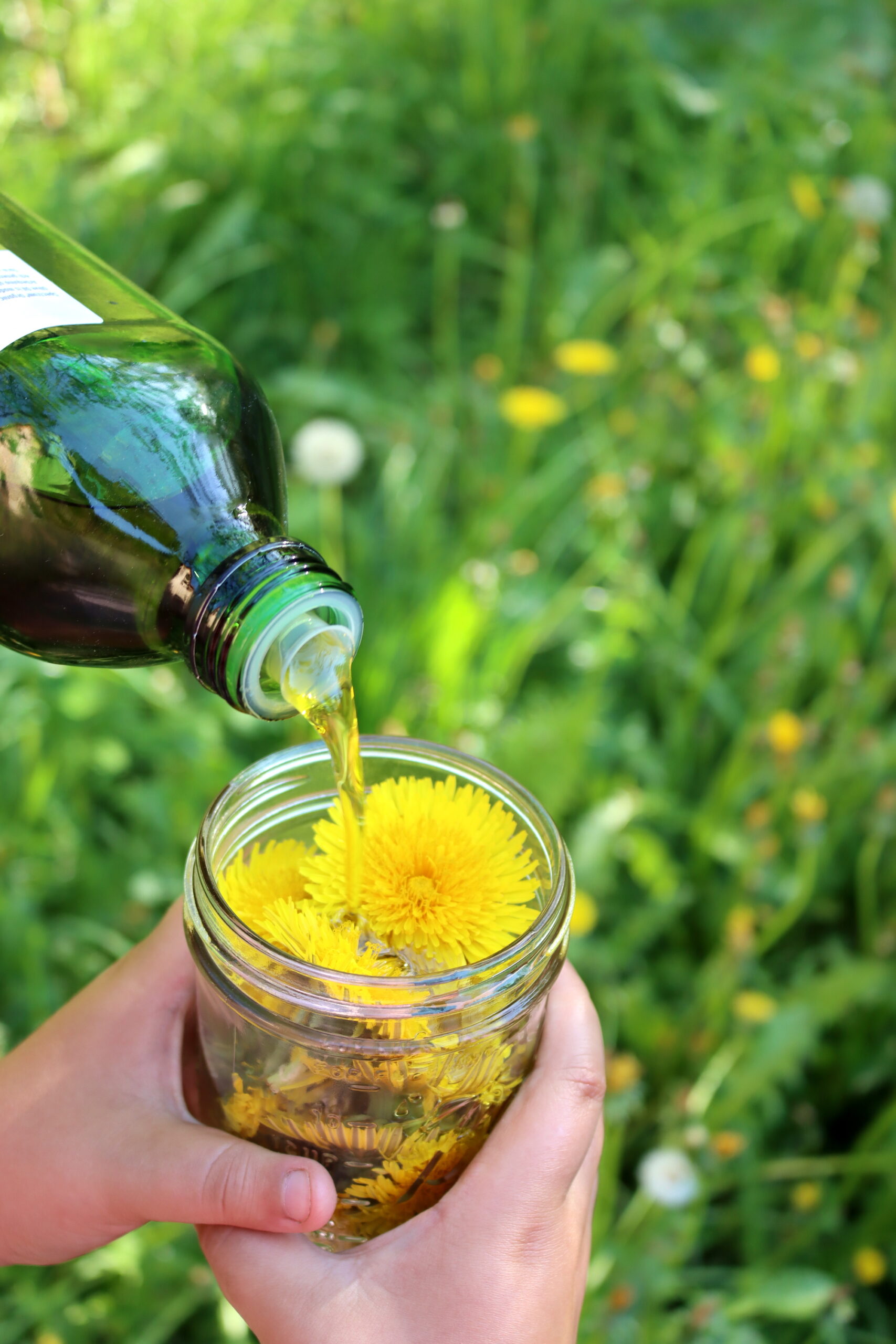
Next, prepare a double boiler by filling the bottom (or your pot or slow cooker) with about one inch of water. Then, we’ll set our jar into our DIY double boiler or pour our dandelion flowers and oil into the top of a traditional double boiler. If you’re using a DIY setup, avoid letting the jar sit directly on the bottom of the pot or slow cooker. Instead, set the jar up on a trivet, cotton towel, or canning jar ring.
(If you can’t use a stove or slow cooker, there are alternatives like the cold infusion method that works well with dried plant material.)
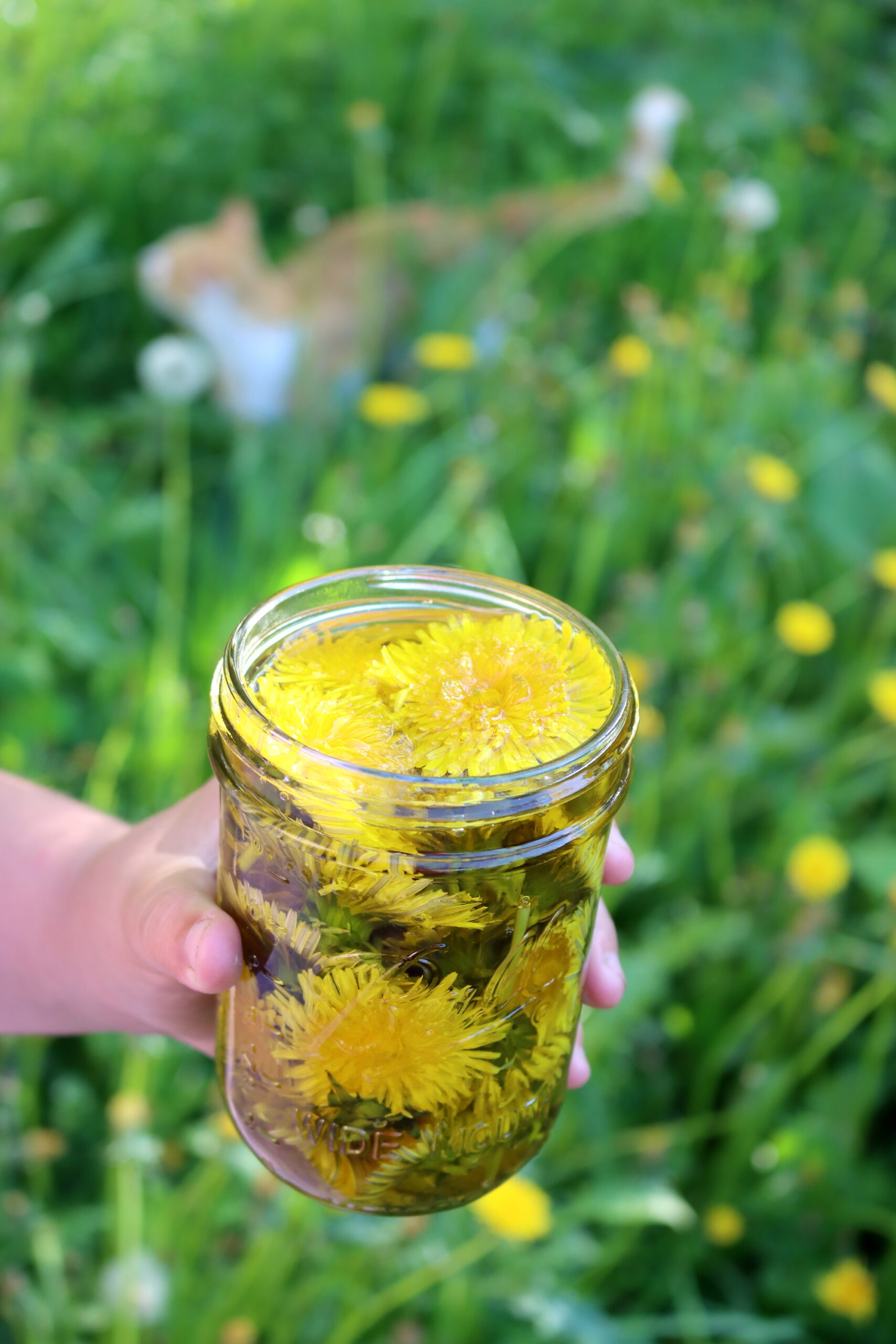
Now, the infusion process begins. Slowly heat your double boiler until it reaches 110 to 120°F and shut the burner or slow cooker off. Heating the water slowly is essential. If you overheat the water, you risk cooking the herbs. We want the oil to slowly warm up, thin, and infuse the herbs, but we don’t want to cook them! Overheating your oil and herbs will result in a less potent salve.
We’ll continue the infusion process over the next 24 to 48 hours. As the water in the double boiler starts to cool, bring it back up to 110 to 120°F and then turn it back off. The idea is to keep it around that temperature range as steadily as possible. I use this strategy overnight, too, but wrap the pot in a towel to hold the heat in longer. Never leave it on for prolonged periods; it will overheat. You should also carefully monitor the water level, adding water as needed to keep it around one inch deep.
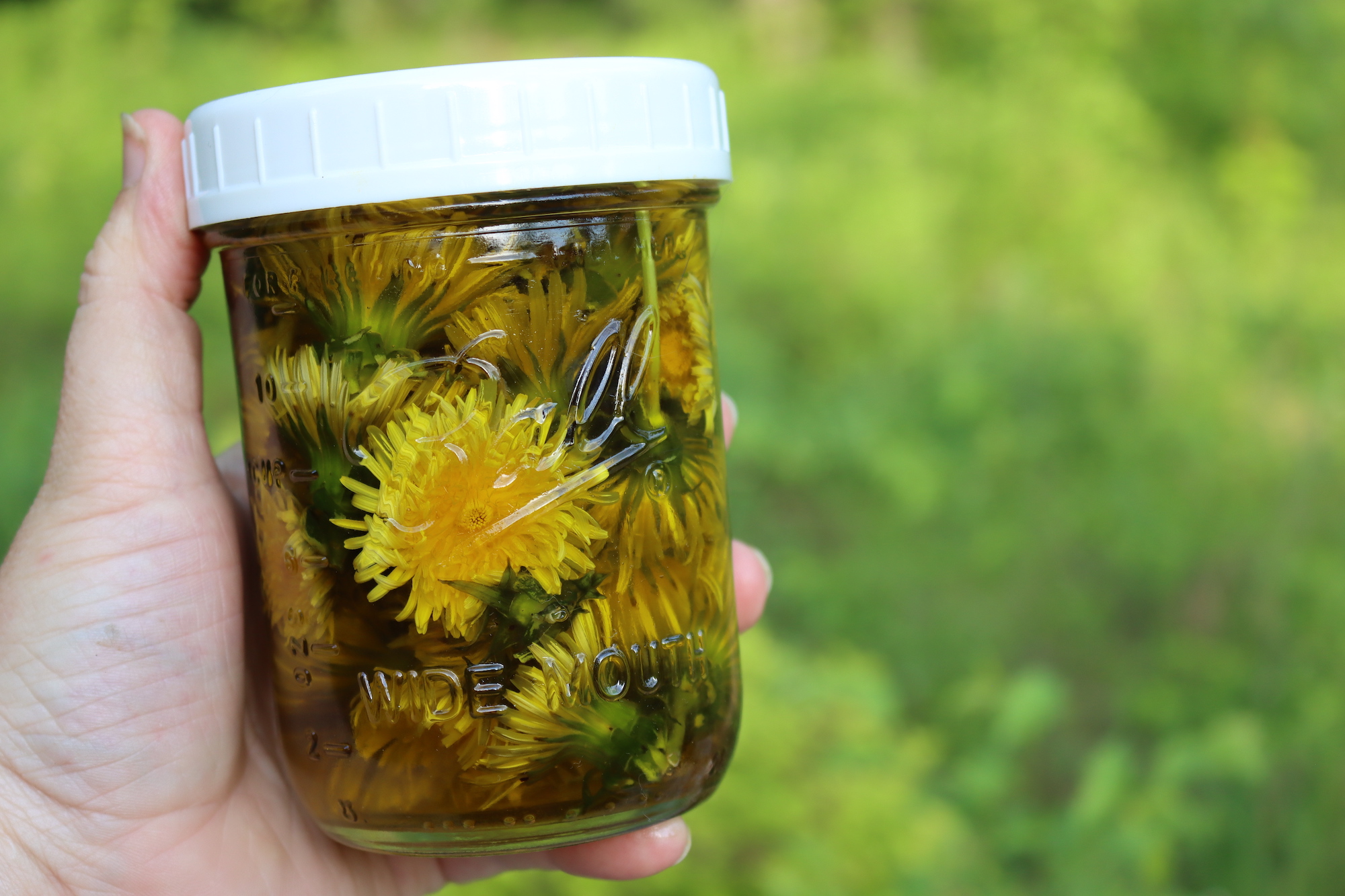
After 24 to 48, when you’re satisfied with the infusion, you can make your salve. Start by straining out the dandelion flowers. Depending on how fine the pieces are, you may need to line your strainer with cheesecloth. Compost the flowers and place the oil back into the top of the double boiler or a heat-proof container like a mason jar.
Bring the water in the double boiler to a simmer and add the beeswax to your infused oil. Stir the beeswax and oil constantly until the beeswax has fully melted and incorporated into the soil.
If you don’t have a kitchen scale or one-ounce blocks of beeswax, you can make a rough measurement with beeswax pellets. One ounce of beeswax is roughly equivalent to one heaping tablespoon of beeswax pellets.
Once the salve mixture is smooth, pour it into your tins or glass containers to cool and set up. Wait at least 30 minutes before using.
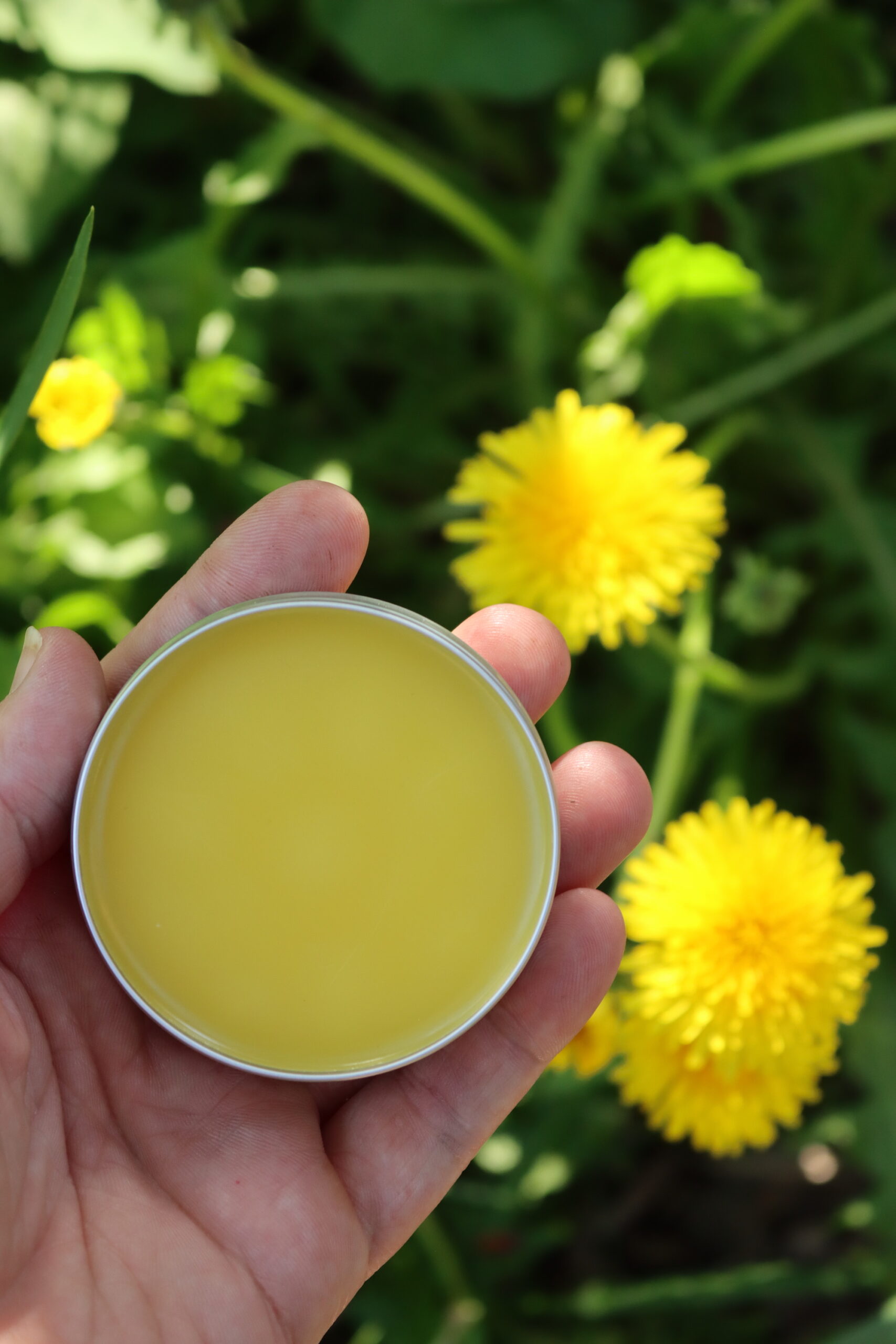
Your dandelion salve is shelf-stable for about a year. While you can continue using it after this, it will start to lose potency. I aim to make only what my family can use in a year and make a fresh batch every summer. If you make a lot more than you will be able to use, dandelion salve makes an excellent gift!
Ways to Use Dandelions
Looking for other ways to use dandelions?
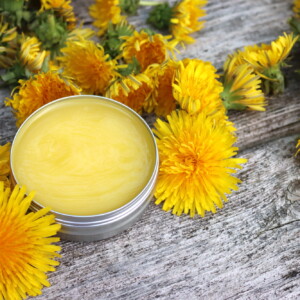
Dandelion Salve
Equipment
Ingredients
- 1 1/2 to 2 cups of fresh dandelion flowers
- 1 1/4 to 1 1/2 cups of olive oil or other neutral, soothing oil – see above options
- 1 ounce of beeswax
Instructions
- Harvest enough fresh dandelion flowers to fill a pint mason jar. Make sure they’re packed down well and chop them up if desired.
- Fill the jar with olive oil (or other neutral oil), covering all of the dandelion flowers.
- Add one inch of water to the bottom of your pot, slow cooker, or double boiler. Place your jar of oil and flowers into your DIY double boiler, or put the material into a traditional double boiler. If using a DIY option, set the jar on a trivet so it doesn’t touch the bottom of the pot.
- Slowly heat the water to 110 to 120°F and turn off the heat.
- Repeat step four periodically as the water cools off during the next 24 to 48 hours. Don’t leave the heat on for a prolonged period, and add water to the double boiler as necessary to avoid overheating the dandelions and oil.
- After 24 to 48 hours, when you’re satisfied with the infusion, strain out the dandelion flowers.
- Add the oil back to the jar or double boiler and bring the water to a simmer.
- Add the beeswax to the warm oil, stirring constantly until the mixture is smooth.
- Turn off the heat and pour your finished salves into tins of glass jars.
- Set aside for at least 30 minutes to cool before use.
Homemade Herbal Salve Recipes
Interested in more homemade herbal salve recipes?
Disclaimer on Homemade Herbal Remedies
For the past 20 years, I’ve been foraging wild medicines and treating my family with homemade remedies. However, I am entirely self-taught. I am not a clinical herbalist, doctor, or anyone with the experience that would qualify me to advise you on your health, nor do I claim to be. My information comes from personal experience and a bit of research. I provide it here purely as a reference for other folks interested in learning more about medicinal plants.
My herbal remedy posts are excellent starting points. I always recommend that you do your own research and verify everything you read (from any source) with multiple reputable sources.
Even if you know how to identify and use medicinal herbs correctly, there’s always a chance of an adverse reaction, particularly with herbs that are new to you. Some people have allergic reactions to even the mildest medicinal plants like chamomile. Always consult your physician or a clinical herbalist before trying a new medicinal plant or remedy. Herbal remedies can cause allergic reactions, interfere with other herbs, supplements, and medications, or have unintended side effects.
If you want to learn more about herbal medicine, from crafting remedies to growing and identifying medicinal plants, I highly recommend checking out the course offered by the Herbal Academy of New England. The Introduction to Herbal Medicine course and the family herbalist group courses are great options for new herbalists.
I have also taken and recommend their mushroom course, which covers medicinal and edible mushrooms, and their Botany and Wildcrafting course. Both are fun, inspiring, informative, and easy to follow.
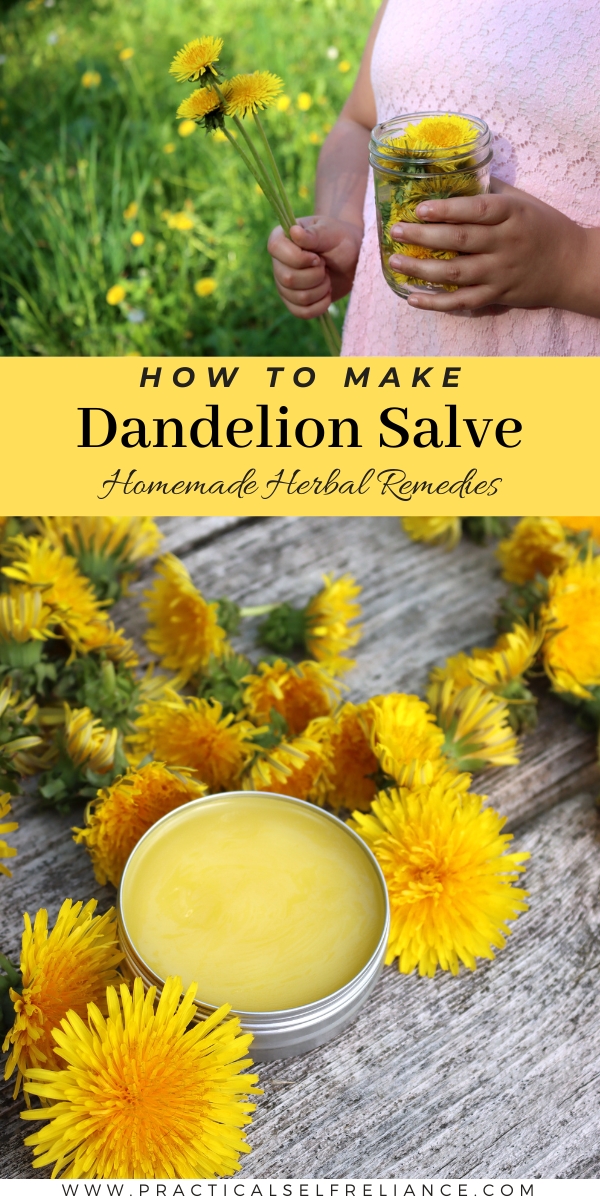
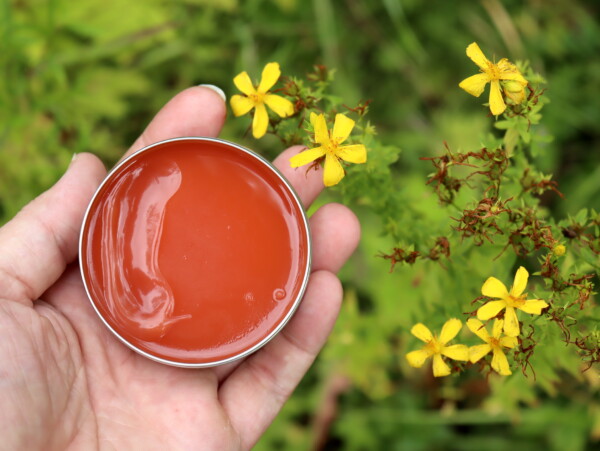
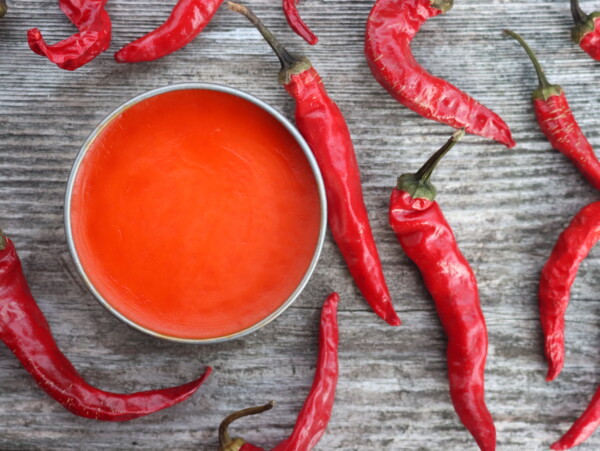
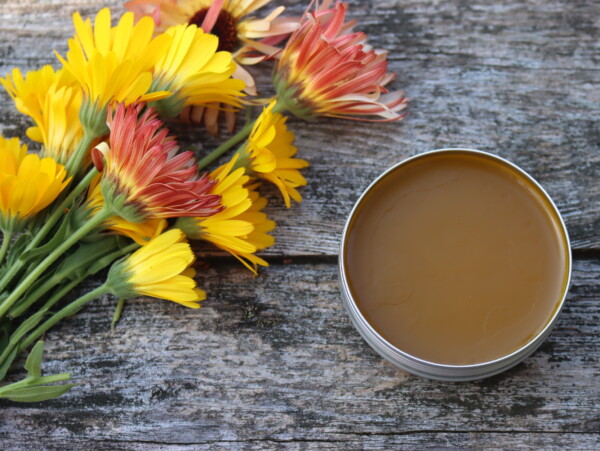
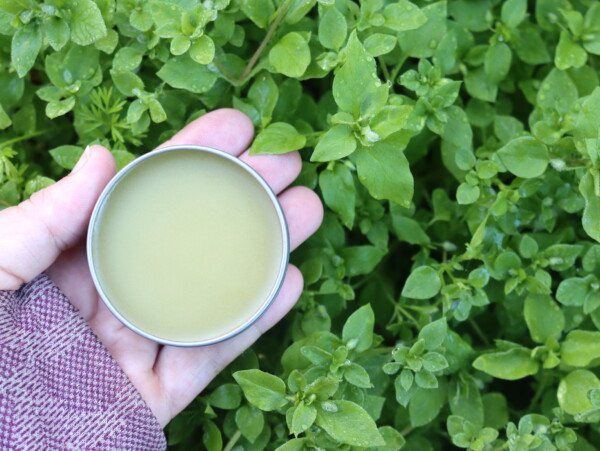
Sorry, one more question: With your dandelion wine recipe, it says to peel away the green stem part away that holds all of the yellow and white flower parts. In this recipe, you say to clip it where the flower joins the stem, but I’m not sure where that would be. Is the green part medicinal, or should I peel it all away like I do when making wine? This would be easier as there are not nearly the amount of flowers required! From the pictures, it looks like the green is somewhat left on. Any advice is appreciated!
The green part is both edible and medicinal, but it’s bitter. In wine, it makes the wine taste bitter and tannic. In a salve though, it’s completely fine, as you’re not drinking it by the glass. The green sepals actually add to the salve. It is much easier to make this one since you don’t have to go through all that time consuming effort to peel away the green parts.
Thank you so much for your excellent explanation. I am loving the recipe more and more! I’m glad that you thought that the dehydrator idea was a good one. I have some salve going in the mini crockpot, but next time maybe I’ll use the dehydrator! All the best, Barb
Reading this, I was wondering if a dehydrator would work. I use mine to make yogurt all of the time. I can set the time and temperature and walk away. Would there be a reason not to use it? I am eager to try the dandelion salve.
That sounds like an excellent idea! I have made yogurt in mine, but for some reason I never thought of infusing a salve in it! Why didn’t I think of that?!?!?! Thanks so much!
Hi
I’m wondering how much beeswax is used in this recipe. I want to give this a go, but don’t want the salve turning out rock solid. Thanks
This one uses 1 ounce of beeswax. You can use a bit less if you’d like to absolutely make sure that it’s very spreadable, but I’ve found 1 ounce buy weight is just about perfect. If it is too hard, you can gently warm it again, dump it back out of the tins and add a bit more oil to remake.
Hi
How do you keep the temperature while sleeping? Don’t know how to do it for 24-48 hours 😕, and how will you know it’s already done?
Thank you
It doesn’t have to be exact. Overnight, I treat it like I do when I’m making yogurt, where you just want to keep it as warm as you can without cooking it. So I’ll get it warm one last time before bed, then remove from the heat and wrap it in a towel to maintain as much warmth as I can. The next morning, take off the towel and warm it again. There’s no knowing when it’s done, as you could keep it warm and infusing for longer if you like, up to maybe 3-4 days. After that, the flowers may start to spoil, so just infuse as best you can in the time you have, then strain.